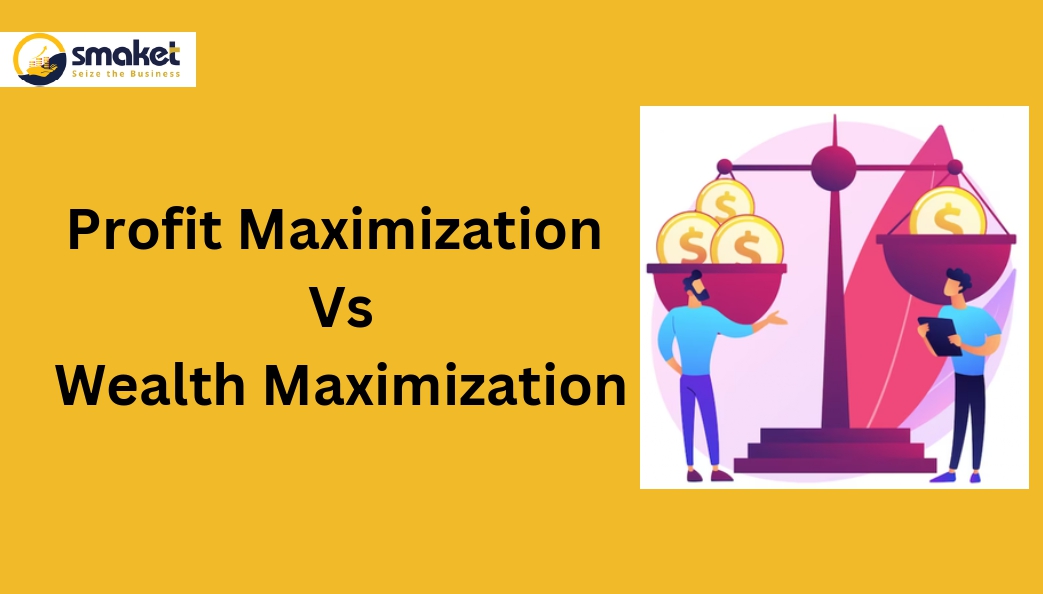When it comes to financial management, businesses try to optimise their total value and achieve long-term success. Wealth and profit maximisation are two significant concepts that are regularly applied. Even if each plan has benefits, it’s crucial to understand how they differ when establishing business strategies and financial goals. In this essay, we will investigate the distinctions between optimising profit and maximising wealth, underlining their significance and implications.
Profit Maximization:
Profit maximisation is a common goal sought by companies in a variety of sectors. Simple short-term profit maximisation is the goal, often within a predetermined accounting period. The main goal is to widen the gap between total revenues and total expenses. Businesses may increase profits by determining the best price, cost structure, and production level. The fundamental tenet of profit maximisation is that short-term profits will result in sustainability and wealth development over the long run.
Profit maximisation has restrictions, though. This method frequently ignores elements like risk, the time value of money, and the effects on parties other than shareholders. By only concentrating on immediate earnings, important factors like long-term development, reinvestment, and sustainability may go unnoticed. As a result, a different technique known as wealth maximisation arises as a more all-encompassing and all-encompassing financial management plan.
Wealth Maximization:
The goal of wealth maximisation, often referred to as value maximisation, is to maximise wealth rather than maximise profits. Wealth maximisation tries to raise the long-term worth of the company instead of emphasising short-term profitability. This strategy acknowledges that value derives from a variety of sources, including reputation, customer happiness, brand equity, and staff wellbeing, in addition to earnings.
The complexity and unpredictability of corporate operations are taken into consideration by wealth maximisation by including the time value of money, risk analysis, and strategic decision-making. While taking into account the interests of other stakeholders, including as employees, customers, and the community, it aims to increase shareholder value. Wealth maximisation, as opposed to profit maximisation, recognises the significance of sustainable growth and long-term viability.
Key Differences:
Time Horizon:
While wealth maximisation has a more long-term approach and takes into account sustainable development and value creation over time, profit maximisation concentrates on short-term benefits within a single accounting period.
Scope:
Profit maximisation has a strong emphasis on increasing profits alone, whereas wealth maximisation takes a wider variety of considerations into account, including community impact, employee wellbeing, and customer pleasure.
Risk and Uncertainty:
Risk analysis and strategic decision-making are both included into wealth maximisation in order to reduce uncertainty and maximise long-term value. Profit maximisation could ignore any opportunities or hazards connected to corporate operations.
Stakeholder Consideration:
While wealth maximisation recognises the need of balancing the requirements of many stakeholders, including shareholders, employees, consumers, and the community, profit maximisation primarily serves the interests of shareholders.
Conclusion:
Although both wealth maximisation and profit maximisation are legitimate methods to financial management, their objectives, time horizons, and other factors vary. Profit maximisation puts an emphasis on quick wins and ignores certain important elements, whereas wealth maximisation takes a more holistic approach and strives for long-term value creation and sustainable growth.
FAQ:
01.What is profit maximisation, exactly?
A financial management strategy called profit maximisation aims to increase short-term earnings throughout a certain accounting period. It seeks to widen the gap between total revenues and total expenses.
02.What is wealth maximisation, exactly?
A financial management method called wealth maximisation, often referred to as value maximisation, tries to raise a company’s overall worth through time. It takes into account aspects other than income, such reputation, client happiness, brand equity, and staff wellbeing.
03.Why is maximising profits important?
Profit maximisation is crucial for businesses because it enables them to create quick returns and can support short-term financial stability. It is a common goal that businesses in several sectors pursue.
04. What are the constraints placed on profit maximisation?
Profit maximisation has limits since it frequently ignores elements like risk, the time value of money, and the effects on parties other than shareholders. It could overlook sustainability, reinvestment, and long-term growth.
05. How does profit maximisation compare to wealth maximisation?
Profit maximisation and wealth maximisation are distinct in a number of ways. Wealth maximisation has a long-term view, striving for sustainable development and value creation through time, as opposed to profit maximisation, which concentrates on short-term gains. Beyond only earnings, wealth maximisation takes a wider variety of variables and stakeholders into account.

